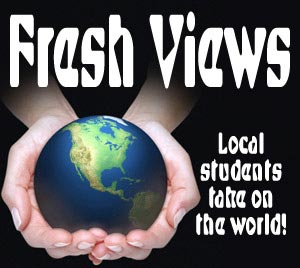| NIE Home | Sponsors | E FAQs | Order Form | Contact Us |

Common Core State Standard
SL.CCS.1/2/3/4 Grades 6-12: An essay of a current news event is provided for discussion to encourage participation, but also inspire the use of evidence to support logical claims using the main ideas of the article. Students must analyze background information provided about a current event within the news, draw out the main ideas and key details, and review different opinions on the issue. Then, students should present their own claims using facts and analysis for support. FOR THE WEEK OF OCT. 03, 2011 Where do Americans mostly turn for local news? It depends on what we want to know, study showsNewspapers are relied on for information about local schools, social services and arts or cultural events. Find an example from one of these categories.
Papers also report on other types of media. Look for an article or listing that involves TV, radio or the Internet.
Pick something in the paper or its website that you feel is tough to find on TV or at an online-only news site.
The second most widely followed source of local news isn't the newspaper, Internet or radio. It's the oldest, most basic form of human communication: word of mouth. A new national study highlights the importance of schoolmates, neighbors, friends and co-workers for sharing information. Word of mouth outranks every new and traditional form of news media except local TV news as the most frequently consulted news source in a report last week from the Pew Research Center and Knight Foundation.
Researchers found that we rely on multiple local sources and media, some mass and some personal. TV is the main source for three popular topics -- weather, traffic and breaking news. Newspapers and their websites rank first or tied for first as a relied-upon source for 11 of 16 local topics surveyed, including schools, cultural events and social services.
Among Americans ages 18-39, the Internet (excluding sites owned by newspapers and TV stations) ranks as a top information source for most of the 16 local subjects studied. Still, the report adds: "The data show that newspapers play a much bigger role in people's lives than many may realize. The survey found that 50 percent of people read newspapers or their Web sites for local information at least once a week. People tend to get a much wider array of information from newspapers than from television."
Front Page Talking Points is written by
Alan Stamm for NIEonline.com, Copyright 2025
Front Page Talking Points Archive►Courts try to halt rushed removals of alleged gang members, testing presidential powers ►U.S. Education Department shrinks as the president tries to 'move education back to the states' ►Batter up: Odd-looking 'torpedo bat' apparently can help players smash home runs ►Top U.S. officials mistakenly leaked Yemen attack phone chat messages before jets and missiles flew ►Trump stirs drama with talk of wanting Greenland, Canada and the Panama Canal ►Measles outbreaks bring reminders of need for childhood vaccines ►White House media policy changes spark lawsuit by AP and concerns about presidential access ►'America has turned:' Trump veers away from backing Ukraine in war against Russian invaders |
Step onto any school campus and you'll feel its energy. Each school is turbocharged with the power of young minds, bodies, hearts and spirits.
Here on the Western Slope, young citizens are honing and testing their skills to take on a rapidly changing world. Largely thanks to technology, they are in the midst of the most profound seismic shift the world has ever seen.
Perhaps no time in our history has it been more important to know what our youth are thinking, feeling and expressing.
The Sentinel is proud to spotlight some of their endeavors. Read on to see how some thoroughly modern students are helping learners of all ages connect with notable figures of the past.
Online ordering
Now you can register online to start getting replica e-editions in your classroom.
Sponsors needed
Even small donations make a big difference in a child's education.
If you are interested in becoming a Partner In Education, please call 970-256-4299 or e-mail nie@GJSentinel.com

